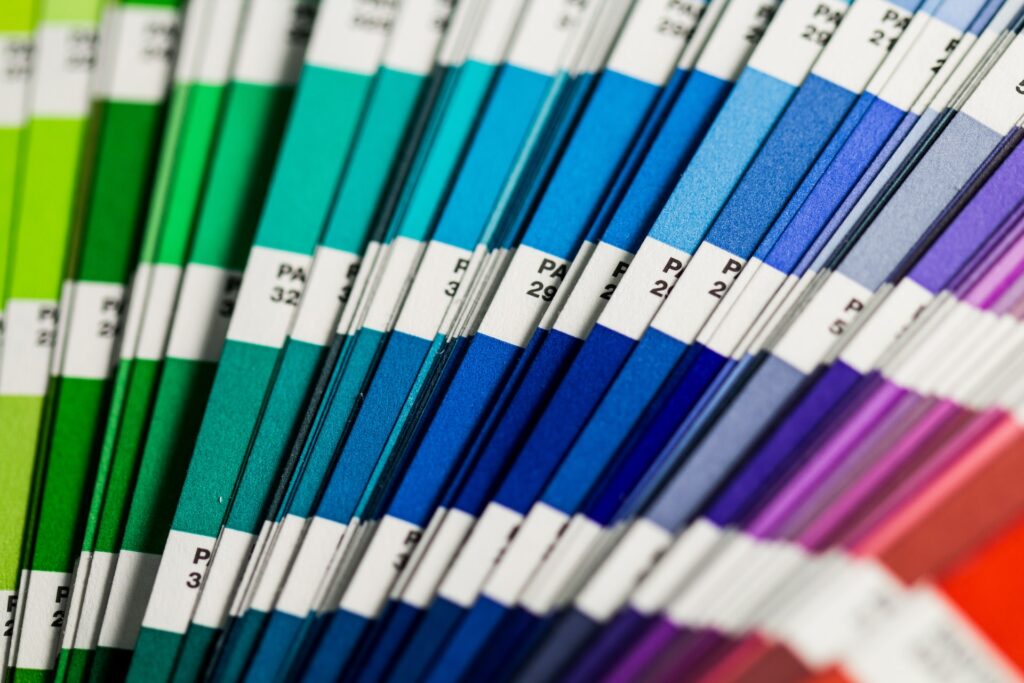The study of colour’s impact on emotions and behaviour is known as colour psychology. The use of colour in interior design can have a significant impact on the tone and atmosphere of a space. The right colour scheme can transform a room and create the desired atmosphere, from soothing blues to energising reds.
The intended use of the space should be taken into account when selecting colours for a room. A home office should be a productive and energising environment, while a bedroom should be a soothing and relaxing space.

Calming Colours:
To create a calm and serene atmosphere, calming hues like blue and green are frequently used in bathrooms and bedrooms. Blues have a reputation for promoting calmness and are thought to lower blood pressure and slow the heart rate. A sense of tranquillity can be added to a room by using greens because they are calming and linked to nature.
Colours that Energise:
In areas where activity and energy are desired, energising colours like red and yellow are frequently used. A bold and energising colour like red can pique excitement and stimulate the mind. The happy colour yellow can infuse a space with a sense of joy and optimism. However, it’s crucial to use these colours sparingly because they can be overpowering in high concentrations.
Neutral Colours:
The foundation of a colour scheme is frequently made up of neutral hues like beige and grey. Since they are adaptable, it is simple to combine them with other hues to produce a space that is both harmonious and well-balanced. Additionally, neutral colours can contribute to the feeling of peace and tranquillity.
Warm Colour Schemes:
Warm hues like orange and yellow are frequently utilised to create a welcoming and inviting atmosphere. These hues are preferred for living rooms and dining rooms because it is thought that they encourage conversation and social interaction.
Cool Colours:
Cool colours like blue and green are frequently used to produce a soothing and relaxing atmosphere. These hues are preferred for bedrooms and bathrooms because it is thought that they have a calming effect on the body and mind.
Colour Intensity:
A colour’s psychological effects can also be influenced by its intensity. Muted and soft colours are frequently associated with calm and serenity, while bright and bold colours are frequently associated with energy and excitement. Using various shades, tints, and tones, interior designers can alter the intensity of a colour.
Colour Meanings:
Utilising colour symbolism is another aspect of colour psychology in interior design. The cultural and emotional attribution of a colour to a particular meaning is known as colour symbolism. As an illustration, the colours red and yellow are frequently connected to happiness and optimism respectively. You can design a space that evokes particular feelings and meanings by incorporating colour symbolism into your colour scheme.
How to Choose a Room’s Colours:
It’s crucial to take into account the room’s existing furnishings and flooring when choosing colours for a space. The colours of these elements can greatly impact the overall colour scheme of a room. For example, if you have dark wood flooring, you may want to choose light-coloured walls to create a sense of balance.
Natural Light:
In addition, the amount of natural light in a room can also impact the colour scheme. A room with a lot of natural light can handle bold and bright colours, while a room with limited natural light may benefit from lighter and softer colours.
Personal Preference:
Choosing colours for a room should also take into account your personal preferences.
Impact:
The impact of colour psychology in interior design cannot be underestimated. From calming blues to energising reds, the right colour scheme can transform a room and create the desired atmosphere. By considering the intended purpose of the space, the intensity of the colours, colour symbolism, existing elements in the room, amount of natural light, and personal preference, you can create a colour scheme that not only looks great but also enhances the mood and feel of the space.
Effects:
When incorporating colour psychology into your interior design, it’s important to keep in mind that colours can have different effects on different people. What may be calming for one person may be energising for another. It’s also important to experiment and find the colours that work best for you and your space.
Experimenting:
One way to experiment with colour psychology in interior design is to start with a neutral base and add pops of colour with accents such as pillows, curtains, or artwork. This allows you to test out different colours and see how they impact the mood and feel of the space before making a larger commitment.
Colour Blocking:
Another way to incorporate colour psychology into your interior design is to use colour blocking. Colour blocking is the use of one or two colours in large blocks to create a bold and impactful statement. This technique can be especially effective in small spaces where you want to create a strong visual impact.
Colour Wheel:
When choosing colours for a room, it’s also important to consider the colour wheel. The colour wheel is a tool that helps to identify colour relationships and how they can be used together. For example, colours that are opposite each other on the colour wheel, such as blue and orange, are said to be complementary and can create a harmonious and balanced colour scheme.
Texture:
In addition, the use of texture can also enhance the impact of colour in interior design. For example, a room with a neutral colour scheme can be made more interesting and dynamic by adding texture through different fabrics, materials, and patterns.
Summary:
In conclusion, the impact of colour psychology in interior design is significant. From creating a peaceful and serene atmosphere to a bold and impactful statement, the right colour scheme can transform a space and enhance the mood and feel of the room. By considering the intended purpose of the space, the intensity of the colours, colour symbolism, existing elements in the room, amount of natural light, and personal preference, you can create a colour scheme that not only looks great but also has a positive impact on your well-being. Your personal style and taste can greatly impact the colours you choose, as well as the atmosphere you want to create in the space.





